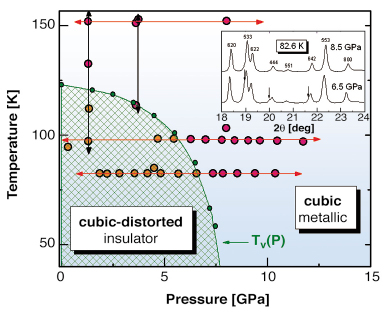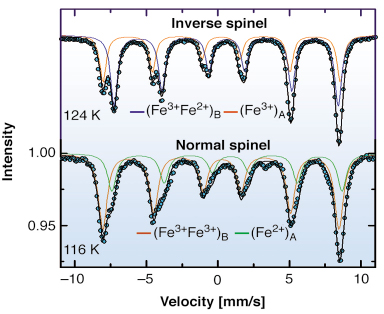- Home
- Users & Science
- Scientific Documentation
- ESRF Highlights
- ESRF Highlights 2006
- Materials Science
- The origin of the Verwey transition in magnetite
The origin of the Verwey transition in magnetite
Magnetite (Fe3O4) is a fascinating natural mineral which is a metallic ferrimagnet at ambient conditions. It was used by early navigators to locate the magnetic North Pole and is synthesised naturally in living species such as fish and birds to be used as magneto-receptors in their navigation. Magnetite has become an important ingredient in the formation of metallic/magnetic nano-composites.
In 1939 Verwey discovered [1] a remarkable phenomenon in magnetite, a discontinuous drop in the conductance on cooling the sample below 122 K. This temperature TV has been nicknamed the Verwey temperature and was shown to be dependent on stoichiometry. Since then magnetite became the subject of numerous structural, electronic/magnetic and thermodynamic studies. It is the only mixed-valence iron oxide and has an inverse spinel cubic structure, AB2O4, at ambient conditions. The octahedral six-coordinated B-site, twice as abundant as the A-site, is equally occupied by Fe3+ and Fe2+ whereas the tetrahedral four-coordinated A-site is occupied by Fe3+. The presence of the mixed-valence in the B sites motivated Verwey and many others, including Mott, to hypothesise that electronic exchange [Fe2+Fe3+]B ![]() [2Fe3+ + e–]B between the ferrous and ferric ions take place above TV (Verwey-Mott theory). Charge disorder (CD) within the B–site, propagating throughout the crystal, would then explain the metallic nature of magnetite at T > TV, whereas the onset of charge ordering (CO) within the B-site below TV would explain the observed metal-insulator transition.
[2Fe3+ + e–]B between the ferrous and ferric ions take place above TV (Verwey-Mott theory). Charge disorder (CD) within the B–site, propagating throughout the crystal, would then explain the metallic nature of magnetite at T > TV, whereas the onset of charge ordering (CO) within the B-site below TV would explain the observed metal-insulator transition.
In recent years we have witnessed numerous studies searching for the elusive charge ordering taking place along the B-site, namely, for a transition from a CD-state (metallic) to a CO-state (insulator):
![]()
Several studies with spectroscopy sensitive to Fe valence have been applied to verify this theory but none could assert the onset of the CD ![]() CO below TV. At T ≤ TDIST a first-order structure phase transition also takes place: a cubic to distorted-cubic spinel at T = TDIST.
CO below TV. At T ≤ TDIST a first-order structure phase transition also takes place: a cubic to distorted-cubic spinel at T = TDIST.
We carried out precise high-pressure (HP) X-ray diffraction (XRD) studies to determine the pressure dependence of TDIST and look for a relationship with the well established TV(P) [2]. Measurements were carried out at ID09 using its diamond anvil cell in the 75 < T < 160 K and 0.2 < P < 12 GPa ranges. Hydrostatic pressure conditions were obtained by using He as a pressure medium.
 |
|
Fig. 18: The phase diagram of magnetite in the 0-150 K and 0-15 GPa (P,T) ranges. The shaded area is the insulating region encompassed by 0-120 K, 0-8 GPa and the TV(P) curve, the latter obtained experimentally [2]. Isothermal and isobaric XRD measurements were carried out. The pink and orange circles correspond to the cubic and cubic distorted regimes as deduced from the XRD data and subsequent fitting. The inset shows a case of a PI-induced structural transition at 82.6 K. The 8.5 GPa spectrum corresponds to cubic phase and the 6.5 GPa to the distorted phase. Arrows indicate new peaks corresponding to the new phase. |
The electronic and structural (P,T) phase diagram of magnetite in the above (P,T) ranges is shown in Figure 18. The green curve corresponds to the experimental (dots) electrical measurements of TV(P) [2]. The double-arrowed paths, indicating reversibility of the process, clearly shows structural transformation, cubic ![]() cubic-distorted, once isothermal or isobaric changes take place throughout the border line of TV(P). This establishes the intimate relationship between the electronic and structural transitions. Thus, the cause of the Verwey transition originates from a gap opening once the cubic distorted regime is created, probably within the oxygen p-bands, contradicting the Vervey-Mott concept of CO within the B-sites.
cubic-distorted, once isothermal or isobaric changes take place throughout the border line of TV(P). This establishes the intimate relationship between the electronic and structural transitions. Thus, the cause of the Verwey transition originates from a gap opening once the cubic distorted regime is created, probably within the oxygen p-bands, contradicting the Vervey-Mott concept of CO within the B-sites.
 |
|
Fig. 19: The Mössbauer 124 K (T > TV) spectrum corresponds to the inverse spinel structure with two spectral hyperfine interaction components: two sixfold coordinated (Fe3+Fe2)B, and one fourfold coordinated (Fe3+)A. The 116 K (T < TV) spectrum corresponds to two sixfold coordinated (Fe3+Fe3+)B, and one fourfold coordinated (Fe2+)A, consistent with a normal spinel structure. |
A manifestation of this contradiction was encountered in our recent 57Fe Mössbauer Spectroscopy (MS) studies [3]. At ambient P (see Figure 19) the features of the spectra above and below TV are clearly dissimilar. Both can be fitted with two spectral components, the first corresponding to an inverse- and the second to a normal-spinel.

Within the normal-spinel regime the CO concept becomes redundant, thus providing irrefutable proof that the Verwey-Mott concept is incorrect.
References
[1] E.J. Verwey, Nature (London) 144, 327 (1939).
[2] N. Mori, S. Todo, N. Takeshita, T. Mori, Y. Akishige, Physica B 312-313, 686 (2002).
[3] M. P. Pasternak, W. M. Xu, G. Kh. Rozenberg, R. D. Taylor, and R. Jeanloz, J. Magn. Magn. Mater., 265, L107 (2003).
Principal Publication and Authors
G. Kh. Rozenberg (a), M.P. Pasternak (a), W.M. Xu (a), Y. Amiel (a), M. Hanfland (b), M. Amboage (b), R.D. Taylor (c), and R. Jeanloz (d), Phys. Rev. Lett. 96, 045705 (2006).
(a) School of Physics and Astronomy, Tel Aviv University (Israel)
(b) ESRF
(c) MST-10, MS-K764, Los Alamos National Laboratory (USA)
(d) Department of Earth and Planetary Science, University of California, Berkeley (USA)



